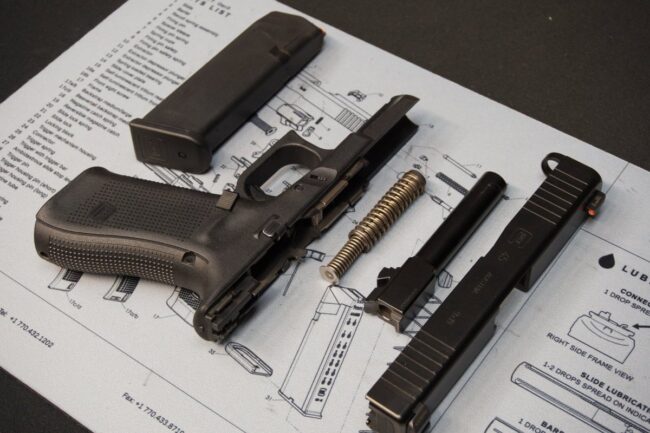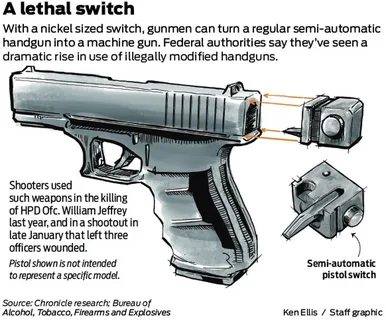The Glock pistol, a favorite among civilians, law enforcement, and military around the world, has earned a reputation for reliability, simplicity, an
The Glock pistol, a favorite among civilians, law enforcement, and military around the world, has earned a reputation for reliability, simplicity, and effectiveness. However, a small but controversial device known as the “Glock switch” has emerged as a serious concern due to its ability to convert a semi-automatic Glock pistol into a fully automatic weapon. This article provides an in-depth examination of what the Glock switch is, how it works, its legal ramifications, and its broader impact on public safety and law enforcement.
Must visit: swiftnewsnow

What Is a Glock Switch?
A Glock switch is a mechanical device designed to convert a semi-automatic Glock handgun into a fully automatic machine pistol. This tiny device, often just a few centimeters long, is attached to the rear of the pistol’s slide. By modifying the pistol’s firing mechanism, the Glock switch allows the weapon to fire continuously as long as the trigger is pressed, rather than firing one round per trigger pull.
Due to its small size, simplicity, and ease of installation, the Glock switch is highly sought after by individuals looking to increase the firepower of a standard Glock pistol without the need for specialized gunsmithing knowledge or equipment.
The Technical Mechanics Behind the Glock Switch
To understand the Glock switch, it’s important to first understand how a Glock pistol functions in its standard form:
- Semi-Automatic Operation: When the trigger is pulled, the firing pin strikes the primer of the cartridge, firing one round. The slide then cycles backward, ejecting the spent casing and chambering a new round. The trigger must be released and pulled again to fire the next round.
- Full-Automatic Operation: In contrast, fully automatic firearms fire continuously while the trigger is held down, firing multiple rounds per second.
The Glock switch works by mechanically altering the internal fire control mechanism—specifically the trigger bar and firing pin safety—to allow the gun to fire multiple rounds continuously without the need to release the trigger between shots. The device effectively “tricks” the pistol into cycling automatically, dramatically increasing the rate of fire.
Why Is the Glock Switch Dangerous?
The conversion from semi-automatic to fully automatic dramatically increases the firing rate, from about 2-3 rounds per second to 15-20 or more rounds per second. This change transforms a handgun designed for precision and controlled fire into a weapon capable of mass rapid fire, substantially increasing its lethality.
Several factors contribute to the danger posed by Glock switches:
- Increased Firepower: Fully automatic capability enables the rapid discharge of dozens of rounds in seconds, overwhelming targets and increasing collateral damage.
- Concealability: The device’s tiny size makes it easy to hide and smuggle, allowing criminals to possess highly lethal weapons covertly.
- Ease of Installation: The switch can be installed quickly by anyone without technical skills, lowering the barrier to converting handguns into automatic weapons.
- Association with Crime: The device has been linked to gang violence, drive-by shootings, and mass shootings, raising alarm among public safety officials.
Legal Status of the Glock Switch
In the United States, Glock switches are classified as “machine guns” under the National Firearms Act (NFA) of 1934 and the Gun Control Act (GCA) of 1968. This classification subjects them to some of the strictest firearm regulations.
- ATF Classification: The Bureau of Alcohol, Tobacco, Firearms and Explosives (ATF) considers any device that converts a firearm to fully automatic fire a machine gun.
- Possession and Manufacture: It is illegal to manufacture, possess, or distribute Glock switches without the appropriate federal licenses and registration.
- Penalties: Violations carry heavy penalties, including felony charges, prison sentences (often exceeding 10 years), hefty fines, and permanent loss of firearm rights.
- State Laws: Many states have additional laws restricting or banning possession, irrespective of federal regulation.
Law Enforcement and Glock Switches
Law enforcement agencies face significant challenges posed by Glock switches:
- Increased Firepower in Criminal Hands: Fully automatic firearms increase the threat level to officers and civilians, complicating engagements and increasing the risk of casualties.
- Detection Difficulties: The small size of Glock switches allows them to be easily concealed, making detection during traffic stops or searches difficult.
- Proliferation Through Illicit Markets: Online marketplaces and 3D printing technology have made these devices more accessible to criminals.
- Training and Awareness: Agencies have increased training for officers to recognize signs of modified firearms and to safely handle encounters involving automatic weapons.
In response, federal agencies like the ATF have conducted operations targeting manufacturers and distributors of Glock switches and increased public education on the risks of such devices.
Practical Limitations of Glock Switches
Despite the dramatic increase in firing rate, Glock switches have limitations:
- Mechanical Stress: Glock pistols are designed for semi-automatic use, not continuous fire. The increased wear and heat can lead to malfunctions or catastrophic failure.
- Reduced Accuracy: Controlling a fully automatic handgun is difficult due to recoil and muzzle climb, decreasing effective accuracy.
- Ammunition Consumption: Fully automatic fire rapidly uses up ammunition, requiring users to carry large quantities.
- Safety Concerns: The increased rate of fire increases the risk of accidental discharge or injury.
Because of these factors, Glock switches are more effective as close-range weapons of intimidation or aggression rather than precision tools.
Societal Impact of Glock Switches
The availability of Glock switches in illicit markets has contributed to increased firearm-related violence, particularly in urban areas where gang activity is prevalent.
- Increased Shootings: The ability to fire dozens of rounds rapidly has led to more lethal encounters and higher casualty counts in shootings.
- Public Safety Risks: Indiscriminate firing increases the chance of innocent bystanders being harmed.
- Community Trauma: Gun violence damages communities through loss of life, psychological trauma, and economic disruption.
- Policy Responses: Rising concerns about Glock switches have fueled calls for stronger gun control measures and increased enforcement.
How to Spot a Glock Switch
Recognizing a Glock switch is crucial for public safety and law enforcement:
- Physical Appearance: The switch typically looks like a small lever or button affixed to the rear of the pistol’s slide.
- Altered Firing Behavior: The pistol fires multiple rounds automatically rather than one shot per trigger pull.
- Unusual Slide Modifications: Modifications around the rear slide may indicate the presence of a switch.
If you suspect a firearm is equipped with a Glock switch, do not handle it and immediately contact law enforcement.
Legal Alternatives for Fully Automatic Firearms
Fully automatic firearms can be legally owned in the U.S., but under strict regulations:
- NFA-Regulated Machine Guns: Firearms manufactured and registered before May 19, 1986, can be legally owned by civilians with proper registration, payment of tax stamps, and background checks.
- Licensed Dealers and Manufacturers: Certain individuals and companies may manufacture and possess fully automatic firearms under federal license.
- Military and Law Enforcement Use: These groups have access to automatic firearms through government channels.
Because of the strict requirements and high cost, legal ownership of automatic firearms remains limited.
Conclusion
The Glock switch, while small and mechanically simple, has significant implications for firearm safety, legality, and public security. It converts a widely owned semi-automatic handgun into a fully automatic weapon, increasing firepower and lethality.
Possession or distribution without federal authorization is illegal and subject to severe penalties. Law enforcement continues to combat the proliferation of these devices due to their role in escalating gun violence.
Public education, enforcement, and adherence to firearm laws are critical to addressing the challenges posed by Glock switches.
Frequently Asked Questions (FAQs)
1. What is a Glock switch?
A Glock switch is a small device that converts a semi-automatic Glock pistol into a fully automatic firearm by modifying its firing mechanism.
2. Is owning a Glock switch legal?
No. Glock switches are classified as machine guns under federal law and possession without authorization is illegal.
3. How does the Glock switch change the gun’s firing?
It allows the gun to fire continuously as long as the trigger is held down instead of one round per trigger pull.
4. Why are Glock switches considered dangerous?
Because they enable rapid-fire capability, increasing the weapon’s lethality and potential for mass harm.
5. How do law enforcement agencies detect Glock switches?
Through physical inspections, forensic analysis, and intelligence on illegal firearm modifications.
6. Are Glock switches easy to install?
Yes, their small size and design allow easy installation without specialized gunsmithing skills.
7. What penalties exist for possessing a Glock switch?
Felony charges with possible prison sentences up to 10 years or more, fines, and loss of firearm privileges.
8. Are there legal ways to own fully automatic firearms?
Yes, but only under strict federal regulation, including registration, tax stamps, and background checks.
9. What should you do if you find or suspect a Glock switch?
Do not handle it. Contact local law enforcement or the ATF immediately.
10. Does a Glock switch affect accuracy?
Yes. Fully automatic fire is harder to control, reducing shooting accuracy.




COMMENTS